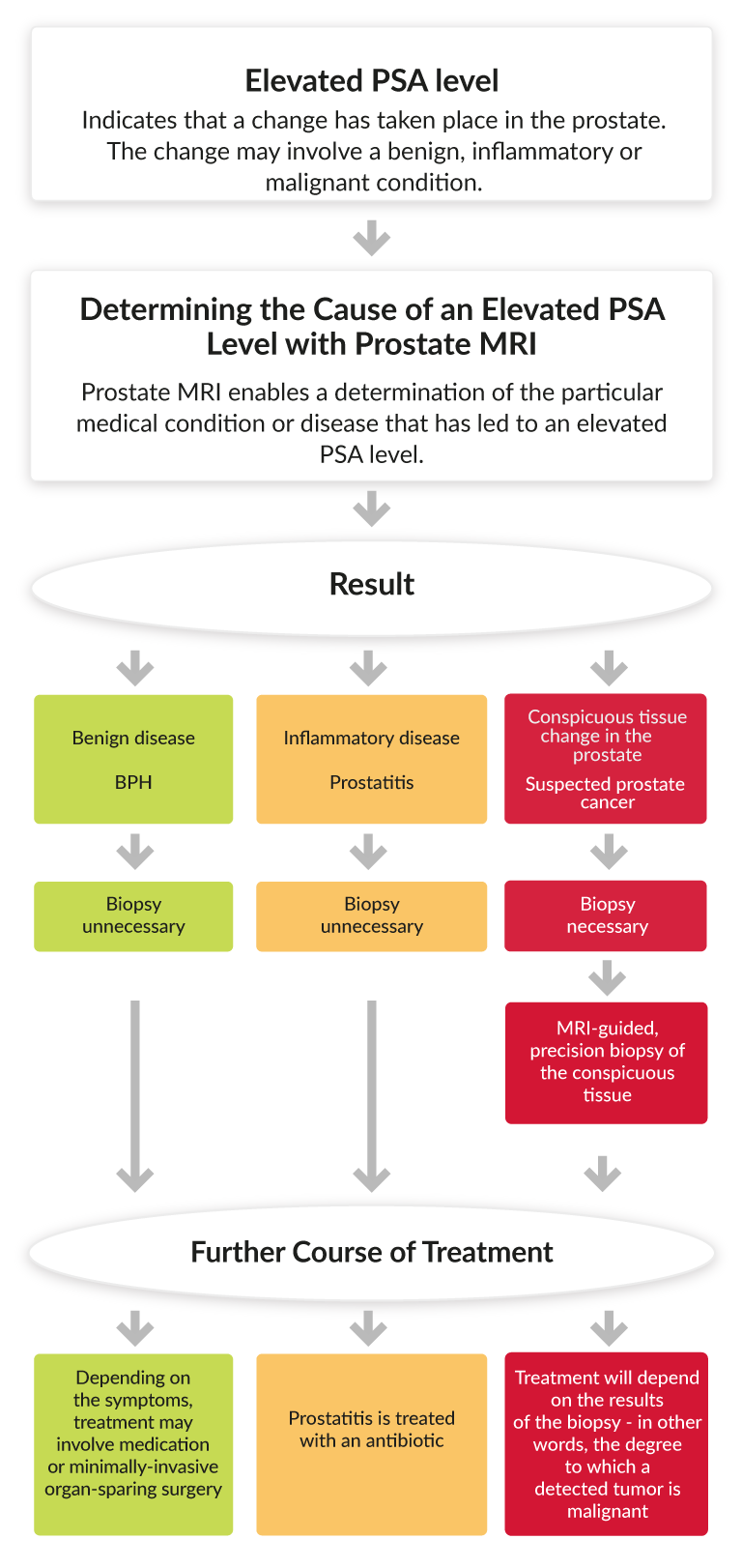PSA Level – Prostate specific antigen
What does PSA stand for?
PSA stands for prostate-specific antigen, a protein that is secreted by cells in the prostate gland to help liquefy the semen. Furthermore, PSA is thought to dissolve cervical mucus, allowing sperm to enter the uterus. Disease-related changes in the prostate usually trigger an increase in the production of PSA. In turn, this increased production leads to higher levels of PSA in the blood – and these higher levels of serum PSA can be detected via a simple blood test.
- PSA Level – Prostate specific antigen
- What does PSA stand for?
- PSA Parameters
- Total PSA
- Complexed PSA
- Free PSA
- Ratio of free PSA to total PSA
- The Role of a PSA Level as an Indicator
- Causes of an Elevated PSA Level
- PSA Score: A Man’s First Encounter with His Prostate
- Changes in Your PSA Level
- Family History and Early Prostate Cancer Screening
- Diagnostic Examination for Elevated PSA Despite a Lack of Symptoms
- Diseases That Cause Elevated PSA Levels
Given that prostate cancer is one of the diseases that can trigger an increase in the production of PSA, it is always important to determine the exact cause of an elevated PSA level. Prostate MRI is an optimal means of determining the cause of elevated PSA levels. This is because MRI enables your doctor to detect and specify the exact location of any of the various changes that can lead to elevated PSA levels.
PSA Parameters

Total PSA
Total PSA is the sum of the complexed (bound) PSA and the free PSA in the blood, typically expressed in nanograms (ng) per milliliter (mL).
Complexed PSA
The level of complexed PSA is the amount of PSA in the blood that is bound to proteins.
Prostate tumors tend to produce higher concentrations of complexed PSA as opposed to free PSA.
Free PSA
The level of free PSA is the amount of free-floating, or unbound, PSA in the blood.
Ratio of free PSA to total PSA
The ratio of free PSA to total PSA is calculated by dividing the amount of free PSA by the amount of total PSA. If the ratio of free PSA is less than 20%, the protein concentration qualifies as elevated. Cancer cells tend to produce more protein in general and more bound PSA in particular. Prostate cancer can therefore lead to an increased PSA level.
If the ratio of free PSA is above 20%, the protein concentration does not qualify as elevated and the likelihood of cancer is regarded as low.
However, experience shows that the free-to-total PSA ratio does not provide a sufficient basis for a diagnosis. That is why we at the ALTA Klinik don’t rely on free-to-total PSA ratios. Instead, we use the ratios merely as an additional indicator of the advisability of an MRI scan.
The Role of a PSA Level as an Indicator
It is not possible to diagnose a specific prostate disease solely on the basis of a PSA test. PSA levels may increase as a result of malignant, acute or age-related changes in the prostate.
Some men may even have all three of the common diseases that affect the prostate, with each disease contributing variously to an elevated PSA level.
The PSA level may reflect all of the relevant changes in the prostate. It is regarded as conspicuous when it is elevated or when it fluctuates.
The PSA level is a good indicator and should only be regarded as an indicator. When taken alone, it offers no certainty as to any specific changes to the prostate and cannot be used as a basis for a diagnosis.
In contrast, an MRI scan of the prostate does provide a reliable basis for a diagnosis.
MRI scans generate hundreds of high-resolution, cross-sectional images of the prostate gland. These images can reveal any changes that may have occurred in the tissue. Using the latest technology and multi-parametric software, we at the ALTA Klinik can even detect very small, early-stage changes in the prostate.
Causes of an Elevated PSA Level
Prostate cancer typically leads to an elevated PSA level. Given that early-stage prostate cancer is generally limited to asymptomatic malignant changes at the cellular level, men have no way of knowing that something is wrong. This is why prostate cancer screening in the form of PSA testing is the best method of early detection. Please refer to the PSA Table for help in interpreting your PSA scores.
In addition to prostate cancer, age-related prostate enlargement (benign prostatic hyperplasia, or BPH), prostatitis (inflammation of the prostate) and urinary tract infections can also lead elevated PSA levels.
PSA Score: A Man’s First Encounter with His Prostate
Many men’s first encounter with their prostate gland is an elevated PSA score. This is because the prostate gland is well hidden in the body and is usually not a source of any sensory experience. Most men also have no idea what its function is.
This state of blissful ignorance can change all of a sudden when their doctors inform them that their PSA levels are elevated. This is usually the moment when those affected begin to concern themselves with their prostate.
In the case of younger men, the cause of an elevated PSA level often turns out to be an acute condition such as an infection that leads to inflammation. For middle-aged men, the list of typical causes will also include age-related prostate enlargement and prostate cancer.
It is important to bear in mind that if your PSA level is elevated, it is important to determine the specific cause of the elevation, no matter what your age bracket is. And an MRI scan of the prostate represents an optimal means of determining the cause.
Changes in Your PSA Level
A PSA level that is in the normal range may nonetheless need clarification if recent blood tests show that it has increased. For instance, an annual PSA test may show that your PSA level has increased from 2 ng/mL to 3 ng/mL. Although your PSA level is under 4 ng/mL, and therefore within the normal range, the increase may have been caused by early-stage prostate cancer.
If your PSA level is already above 4 ng/ml and screening reveals another significant increase, then clarification is even more urgent. That’s why we recommend proactive PSA testing. That being said, regular PSA testing (e.g. once every 3 months) cannot provide a basis for diagnosing the cause of an elevated PSA level.
Family History and Early Prostate Cancer Screening
It is important not to underestimate a family history of prostate disease. For instance, if your father had prostate cancer, your chances of getting prostate cancer will tend to be higher than those of men with no family history of the disease.
Our experience with patients whose family history includes prostate cancer shows that the disease may even appear far earlier in sons than was the case for their fathers. Men with a family history of prostate cancer are therefore advised to begin regular prostate cancer screening in the form of PSA testing at an earlier age in order to enable an earlier response to any conspicuous findings.
We recommend that men begin regular PSA testing at the age of 40. This is because changes in a man’s prostate will generally cause his PSA levels to rise, although there are no physical symptoms of the changes that are taking place.
Diagnostic Examination for Elevated PSA Despite a Lack of Symptoms
Most men find it difficult to understand why they need to have a prostate examination if they’re experiencing no symptoms. Indeed, more than 90% of our patients indicate that they feel quite healthy. While age-related prostate enlargement is more likely to cause symptoms than prostate cancer, it is prostate cancer that men fear most when their PSA level is elevated.
We are able to determine the cause of an elevated PSA level by carrying out an MRI scan of the prostate.
Diseases That Cause Elevated PSA Levels
1. Age-related benign prostatic hyperplasia (BPH)
A significant enlargement of the prostate gland can cause your PSA level to rise. While the overall volume of the prostate tends to increase in men as they age, the increase actually develops only in the transitional zone of the prostate as an abundance of nodules form and begins to compress the peripheral zone. While men often don’t notice the growth directly, it can manifest itself in a more frequent urge to urinate.
2. Age-related BPH combined with chronic inflammation
In addition to BPH, chronic inflammation of the prostate can also lead to an elevated PSA level. In such cases, the two factors can act independently of one another, with each contributing to varying degrees to an increase in your PSA level.
3. Age-related BPH combined with prostate cancer
After learning from their urologists that they have benign prostatic hyperplasia, many men assume that this must also be the reason for their elevated PSA levels. However, while the enlargement will certainly tend to increase their PSA levels, prostate cancer may also be playing a role, for instance, by causing a continuous rise in their PSA levels.
4. Age-related BPH combined with acute prostatitis
The swelling associated with prostatitis usually leads to a noticeable enlargement of the prostate gland. Moreover, prostatitis can also lead to a significant increase in the concentration of PSA in the blood. Men often notice acute prostatitis by a burning sensation when urinating.
5. Age-related BPH combined with multiple different tumors
Some men may have two or more malignant tumors at different locations in the prostate. One tumor may be located in the peripheral zone and another in the transition zone. Such tumors may differ in terms of their malignancy, size and tendency to spread. However, any related PSA-level increases may also be influenced by prostate enlargement and chronic inflammation.
 English
English
 Deutsch
Deutsch  Nederlands
Nederlands 





